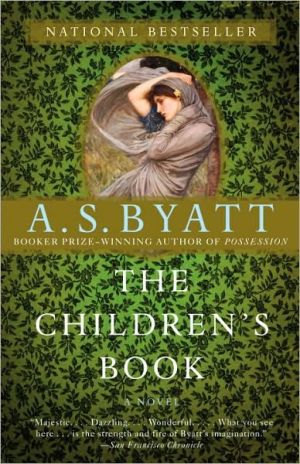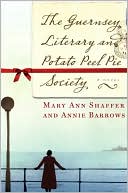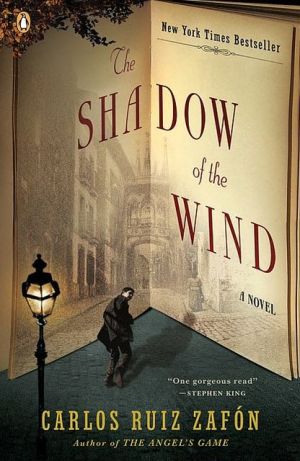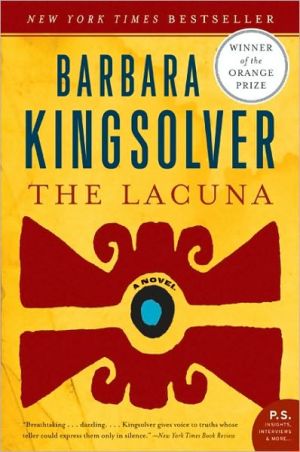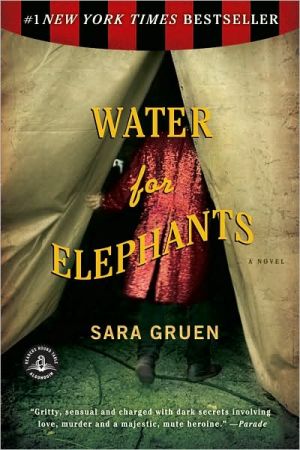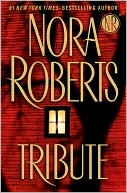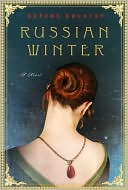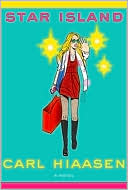The Children's Book
From the renowned author of Possession, The Children’s Book is the absorbing story of the close of what has been called the Edwardian summer: the deceptively languid, blissful period that ended with the cataclysmic destruction of World War I. In this compelling novel, A.S. Byatt summons up a whole era, revealing that beneath its golden surface lay tensions that would explode into war, revolution and unbelievable change — for the generation that came of age before 1914 and, most of all, for...
Search in google:
From the Booker Prize winning author of Possession, a dazzling new novel that spans the years from the Victorian era through World War I and centers around a famous children s book author and the passions, betrayals, and secrets that tear apart the people she loves.When Olive Wellwood s oldest son discovers a runaway named Philip sketching in the basement of the Victoria and Albert Museum a boy who could be a character out of one of Olive s magical tales she takes him into the storybook world of her family and friends.But the midsummer bacchanals the Wellwoods host at their rambling country house and the private books that Olive writes for each of her seven children conceal more treachery and darkness than Philip has ever imagined. As these lives of adults and children alike unfold, lies are revealed, hearts are broken, and the damaging truth about the Wellwoods is slowly uncovered. Yet a far larger...The Barnes & Noble ReviewA. S. Byatt published her first novel in 1964 and, over the ensuing two and a half decades, produced a series of successors that were admired by critics but had little reach beyond intellectual circles. Yet when Possession, her literary romance and thriller, became a bestseller on its publication in 1990, the author evinced no surprise. Quite the contrary: this time, she said, she had written with a larger audience in mind. In tone and scope, the resulting novel proved a gripping and original blend of the Victorian and postmodern, serving up two love stories, some improbably sexy critical theory, and countless deft pastiches of Rossetti and Browning. "I knew people would like it," Byatt told The New York Times. "It's the only one I've written to be liked, and I did it partly to show off."
Two boys stood in the Prince Consort Gallery, and looked down on a third. It was June 19th, 1895. The Prince had died in 1861, and had seen only the beginnings of his ambitious project for a gathering of museums in which the British craftsmen could study the best examples of design. His portrait, modest and medalled,was done inmosaic in the tympanum of a decorative arch at one end of the narrowgallery which ran above the space of the South Court. The South Court was decorated with further mosaics, portraits of painters, sculptors, potters, the "Kensington Valhalla." The third boy was squatting beside one of a series of imposing glass cases displaying gold and silver treasures. Tom, the younger of the two looking down, thought of Snow White in her glass coffin. He thought also, looking up at Albert, that the vessels and spoons and caskets, gleaming in the liquid light under the glass, were like a resurrected kingly burial hoard. (Which, indeed, some of them were.) They could not see the other boy clearly, because he was on the far side of a case. He appeared to be sketching its contents.\ Julian Cain was at home in the South Kensington Museum. His father, Major Prosper Cain, was Special Keeper of Precious Metals.\ Julian was just fifteen, and a boarder at Marlowe School, but was home recovering from a nasty bout of jaundice. He was neither tall nor short, slightly built, with a sharp face and a sallow complexion, even without the jaundice. He wore his straight black hair parted in the centre, and was dressed in a school suit. Tom Wellwood, boyish in Norfolk jacket and breeches, was about two years younger, and looked younger than he was, with large dark eyes, a soft mouth and a smooth head of dark gold hair. The two had not met before. Tom's mother was visiting Julian's father, to ask for help with her research. She was a successful authoress of magical tales. Julian had been deputed to show Tom the treasures. He appeared to be more interested in showing him the squatting boy.\ "I said I'd show you a mystery."\ "I thought you meant one of the treasures."\ "No, I meant him. There's something shifty about him. I've been keeping an eye on him. He's up to something."\ Tom was not sure whether this was the sort of make-believe his own family practised, tracking complete strangers and inventing stories about them. He wasn't sure if Julian was, so to speak, playing at being responsible.\ "What does he do?"\ "He does the Indian rope trick. He disappears. Now you see him, now you don't. He's here every day. All by himself. But you can't see where or when he goes."\ They sidled along the wrought-iron gallery, which was hung with thick red velvet curtains. The third boy stayed where he was, drawing intently. Then he moved his position, to see from another angle. He was hay-haired, shaggy and filthy. He had cut-down workmen's trousers, with braces, over a flannel shirt the colour of smoke, stained with soot. Julian said\ "We could go down and stalk him. There are all sorts of odd things about him. He looks very rough. He never seems to go anywhere but here. I've waited at the exit to see him leave, and follow him, and he doesn't seem to leave. He seems to be a permanent fixture."\ The boy looked up, briefly, his grimy face creased in a frown. Tom said\ "He concentrates."\ "He never talks to anyone that I can see. Now and then the art students look at his drawings. But he doesn't chat to them. He just creeps about the place. It's sinister."\ "Do you get many robberies?"\ "My father always says the keepers are criminally casual with the keys to the cases. And there are heaps and heaps of stuff lying around waiting to be catalogued, or sent to Bethnal Green. It would be terribly easy to sneak off with things. I don't even know if anyone would notice if you did, not with some of the things, though they'd notice quickly enough if anyone made an attempt on the Candlestick."\ "Candlestick?"\ "The Gloucester Candlestick. What he seems to be drawing, a lot of the time. The lump of gold, in the centre of that case. It's ancient and unique. I'll show it to you. We could go down, and go up to it, and disturb him." Tom was dubious about this. There was something tense about the third boy, a tough prepared energy he didn't even realise he'd noticed.\ However, he agreed. He usually agreed to things. They moved, sleuthlike, from ambush to ambush behind the swags of velvet. They went under Prince Albert, out onto the turning stone stairs, down to the South Court. When they reached the Candlestick, the dirty boy was not there.\ "He wasn't on the stairs," said Julian, obsessed.\ Tom stopped to stare at the Candlestick. It was dully gold. It seemed heavy. It stood on three feet, each of which was a long-eared dragon, grasping a bone with grim claws, gnawing with sharp teeth. The rim of the spiked cup that held the candle was also supported by open-jawed dragons with wings and snaking tails. The whole of its thick stem was wrought of fantastic foliage, amongst which men and monsters, centaurs and monkeys, writhed, grinned, grimaced, grasped and stabbed at each other. A helmeted, gnomelike being, with huge eyes, grappled the sinuous tail of a reptile. There were other human or kobold figures, one in particular with long draggling hair and a mournful gaze. Tom thought immediately that hismotherwould need to see it. He tried, and failed, to memorise the shapes. Julian explained. It had an interesting history, he said. No one knew exactly what it was made of. It was some kind of gilt alloy. Itwas probable that it had been made in Canterbury—modelled in wax and cast—but apart from the symbols of the evangelists on the knop, it appeared not to be made for a religious use. It had turned up in the cathedral in Le Mans, from where it had disappeared during the French Revolution. A French antiquary had sold it to the Russian Prince Soltikoff. The South KensingtonMuseum had acquired it from his collection in 1861. There was nothing, anywhere, like it.\ Tom did not know what a knop was, and did not know what the symbols of the evangelists were. But he saw that the thing was a whole world of secret stories. He said his mother would like to see it. It might be just what she was looking for. He would have liked to touch the heads of the dragons.\ Julian was looking restlessly around him. There was a concealed door, behind a plaster cast of a guarding knight, on a marble plinth. It was slightly ajar, which he had never seen before. He had tried its handle, and it was always, as it should be, since it led down to the basement storerooms and workrooms, locked.\ "I bet he went down there."\ "What's down there?"\ "Miles and miles of passages and cupboards and cellars, and things being moulded, or cleaned, or just kept. Let's stalk him."\ There was no light, beyond what was cast on the upper steps from the door they had opened. Tom did not like the dark. He did not like transgression. He said "We can't see where we're going."\ "We'll leave the door open a crack."\ "Someone may come and lock it. We may get into trouble."\ "We won't. I live here."\ They crept down the uneven stone steps, holding a thin iron rail. At the foot of the staircase they found themselves cut off by a metal grille, beyond which stretched a long corridor, now vaguely visible as though there was a light-source at the other end. The passage was roofed with Gothic vaulting, like a church crypt, but finished in white glazed industrial bricks. Julian gave the grille an irritated shake and it swung open. He observed that this, too, should have been locked. Someone was in for trouble.\ The passage opened into a dusty vault, crammed with a crowd of white effigies, men, women and children, staring out with sightless eyes. Tom thought they might be prisoners in the underworld, or even the damned. They were closely packed; the boys had to worm their way between them. Beyond this funereal chamber, two corridors branched. There was more light to the left, so they went that way, negotiated another unlocked grille, and found themselves in a treasure-house of vast gold and silver vessels, croziers, eagle-winged lecterns, fountains, soaring angels and grinning cherubs. "Electrotypes," whispered the knowledgeable Julian. A faint but steady light rippled over the metal, through little glass roundels let into the brickwork. Julian put his finger to his lips and hissed to Tom to keep still. Tom steadied himself against a silver galleon, which clanged. He sneezed.\ "Don't do that."\ "I can't help it. It's the dust."\ They crept on, took a left, took a right, had to force their way between thickets of what Tom thought were tomb railings, surmounted by jaunty female angel-busts,with wings and pointed breasts. Julian said they were cast-iron radiator covers, commissioned from an ironmaster in Sheffield. "Cost a packet, down here because someone thought they were obtrusive," he whispered. "Which way now?"\ Tom said he had no idea. Julian said they were lost, no one would find them, rats would pick their bones. Someone sneezed. Julian said\ "I told you, don't do that."\ "I didn't. It must have been him."\ Tom was worried about hunting down a probably harmless and innocent boy. He was also worried about encountering a savage and dangerous boy.\ Julian cried "We knowyou're there. Come out and give yourself up!"\ He was alert and smiling, Tom saw, the successful seeker or catcher in games of pursuit.\ There was a silence. Another sneeze. A slight scuffling. Julian and\ Tom turned to look down the other fork of the corridor, which was obstructed by a forest of imitation marble pillars, made to support busts or vases. A wild face, under a mat of hair, appeared at knee height, framed between fake basalt and fake obsidian.\ "You'd better come out and explain yourself," said Julian, with complete certainty. "You're trespassing. I should get the police."\ The third boy came out on all fours, shook himself like a beast, and stood up, supporting himself briefly on the pillars. He was about Julian's height. He was shaking, whether with fear or wrath Tom could not tell. He pushed a dirty hand across his face, rubbing his eyes, which even in the gloom could be seen to be red-rimmed. He put his head down, and tensed. Tom saw the thought go through him, he could charge the two of them, head-butt them and flee down the corridors. He didn't move and didn't answer.\ "What are you doing down here?" Julian insisted.\ "I were hiding."\ "Why? Hiding from who?"\ "Just hiding. I were doing no harm. I move carefully. I don't disturb things."\ "What's your name? Where do you live?"\ "My name's Philip. Philip Warren. I suppose I live here. At present."\ His voice was vaguely north country.Tomrecognised it, but couldn't place it. He was looking at them much as they were looking at him, as though he couldn't quite grasp that they were real. He blinked, and a tremor ran through him. Tom said\ "You were drawing the Candlestick. Is that what you came for?"\ "Aye."\ He was clutching a kind of canvas satchel against his chest, which presumably contained his sketching materials. Tom said\ "It's an amazing thing, isn't it? I hadn't seen it before."\ The other boy looked him in the eye, then, with a flicker of a grin.\ "Aye. Amazing, it is."\ Julian spoke severely.\ "You must come and explain yourself to my father."\ "Oh, your father. Who's he, then?"\ "He's Special Keeper of Precious Metals."\ "Oh. I see."\ "You must come along with us."\ "I see I must. Can I get my things?"\ "Things?" Julian sounded doubtful for the first time. "You mean, you've been living down here?"\ "S'what I said. I got nowhere else to go. I'd rather not sleep on t'streets. I come here to draw. I saw the Museum was for workingmen to see well-made things. I mean to get work, I do, and I need drawings to show . . . I like these things."\ "Can we see the drawings?" asked Tom.\ "Not in this light. Upstairs, if you're interested. I'll get my things, like I said."\ He ducked, and began to make his way back amongst the pillars, crouching and weaving expertly. Tom was put in mind of dwarves in mine-workings, and, since his upbringing was socially conscientious, of children in mines, pulling trucks on hands and knees. Julian was on Philip's heels. Tom followed.\ "Come in," said the grimy boy, at the opening of a small storeroom, making a welcoming gesture, possibly mocking, with an arm. The storeroom contained what appeared to be a small stone hut, carved and ornamented with cherubim and seraphim, eagles and doves, acanthus and vines. It had its own little metal gate, with traces of gilding on the rusting iron.\ "Convenient," said Philip. "It has a stone bed. I took the liberty of borrowing some sacks to keep warm. I'll put 'em back, naturally, where I found them."\ "It's a tomb or shrine," said Julian. "Russian, by the look of it. There must have been some saint on that table, in a glass case or a reliquary.\ He might still be in there, underneath, his bones that is, if he wasn't incorrupt."\ "I haven't noticed him," said Philip, flatly. "He hasn't bothered me."\ Tom said "Are you hungry? What do you eat?"\ "Once or twice I got to help in the tea-room, moving plates and washing them. People leave a lot on their plates, you'd be surprised. And the young ladies from the Art School took notice of my drawings and sometimes they passed me a sandwich. I don't beg. I did steal one, once, when I was desperate, an egg-and-cress sandwich. I were pretty sure the young lady had no intention of eating it."\ He paused.\ "It isn't much," he said. "I'm hungry, yes."\ He was rummaging behind the tomb in the shrine, and came out with another canvas satchel, a sketch-book, a candle stub and what looked like a roll of clothing, tied with string.\ "How did you get in?" Julian persisted.\ "Followed the horses and carts. You know, they turn in and drive down a ramp into these underground parts. And they unload and pack things with a deal of bustle, and it's easy enough to mingle wi' them, wi' the carters and lads, and get in."\ "And the upstairs door?" Julian queried. "Which is meant to be locked at all times."\ "I came across a little key."\ "Came across?"\ "Aye. Came across. I'll give it back. Here, take it."\ Tom said\ "It must be horribly frightening, down here alone at night."\ "Not near so frightening as t'streets in t'East End. Not near."\ Julian said "Please come with me now. You must come and explain all this to my father. He's talking to Tom's mother. This is Tom. Tom Wellwood. I'm Julian Cain."
\ Keith DonohueBristling with life and invention, it is a seductive work by an extraordinarily gifted writer…more compelling than the social and political history is the domestic drama among the dozen or more characters that Byatt draws in vivid detail…The Children's Book holds a mirror to the new middle class during an era of growing appreciation for children and greater sexual freedom for women and for the love that dares not speak its name. That Byatt marries this novel of ideas with such compelling characters testifies to her remarkable spinning energy.\ —The Washington Post\ \ \ \ \ Publishers WeeklyByatt's overstuffed latest wanders from Victorian 1895 through the end of WWI, alighting on subjects as diverse as puppetry, socialism, women's suffrage and the Boer War, and suffers from an unaccountably large cast. The narrative centers on two deeply troubled families of the British artistic intelligentsia: the Fludds and the Wellwoods. Olive Wellwood, the matriarch, is an author of children's books, and their darkness hints at hidden family miseries. The Fludds' secrets are never completely exposed, but the suicidal fits of the father, a celebrated potter, and the disengaged sadness of the mother and children add up to a chilling family history. Byatt's interest in these artists lies with the pain their work indirectly causes their loved ones and the darkness their creations conceal and reveal. The other strongest thread in the story is sex; though the characters' social consciences tend toward the progressive, each of the characters' liaisons are damaging, turning high-minded talk into sinister predation. The novel's moments of magic and humanity, malignant as they may be, are too often interrupted by information dumps that show off Byatt's extensive research. Buried somewhere in here is a fine novel. (Oct.)\ Copyright © Reed Business Information, a division of Reed Elsevier Inc. All rights reserved.\ \ \ Library JournalA girl places some diminutive folk she's discovered into her doll house, then is imprisoned by a giant child herself. A prince discovers that he alone has no shadow. No, these aren't plot points in this masterly new work by the author of Possession but children's stories written by one of its protagonists, Olive Wellwood. There are, or course, actual children in the book—Olive's, with blustery banker-turned-crusader husband Humphrey; the Wellwood cousins; Julian, son of a keeper at the South Kensington Museum; Philip, the wayward boy discovered living surreptitiously in the museum, whom Olive brings home to her country estate; the family of brilliant but selfish master potter Benedict Fludd, who takes in the talented Philip as an unpaid apprentice; and more. Like the children in Olive's stories, these children have their notions quietly disabused; one small instant—say, a parent's overheard comment—and life is changed forever. It's the late 1800s, with new ideas in the air—and it's all rushing toward World War I. VERDICT Pitch perfect, stately, told with breathtakingly matter-of-fact acuteness, this is another winner for Byatt. [See Prepub Alert, LJ 6/1/09.]—Barbara Hoffert, Library Journal\ \ \ \ \ Kirkus ReviewsByatt (A Whistling Woman, 2002, etc.) encompasses the paradigm shift from Victorian to modern England in a sweeping tale of four families. The deeper subject, however, is the complex, not always benign bond that attaches children to adults. As the novel opens in 1895, Olive Wellwood seems the model New Woman: popular author of books that reinvent fairy tales for contemporary children, tolerant wife to Fabian Society stalwart Humphry, devoted mother pregnant with her seventh baby. She takes in Philip Warren, a working-class boy who longs to make art, and connects him with Benedict Fludd, a master potter whose family belongs to the Wellwoods' progressive, artistic circle. As the long, dense narrative unfolds, we see the dark side of these idealists' lives. Three of the children Olive is raising are not hers with Humphry; in another household, magnificent works of art reveal repellent acts of incest. The gothic sexual interconnections recall Bloomsbury, and Olive is clearly a gloss on E. Nesbit, but this is no mere roman a clef. Byatt's concern is the vast area where utopian visions collide with human nature. Her adult subjects, she writes, "saw, in a way that earlier generations had not, that children were people, with identities and desires and intelligences . . . But they saw this, so many of them, out of a desire of their own for perpetual childhood." World War I forces everyone to grow up. Only one son of this socialist set becomes a conscientious objector; the others serve and most of them die. The pace, positively stately in the novel's first half, speeds up and becomes unduly hasty in the final section. But Byatt has painted her large cast of characters so richly that we care aboutall of them even when their fates are summarized in a sentence. In the last chapter, the variously battered survivors reunite and dream once more: "They could make magical plays for a new generation of children."Ambitious, accomplished and intelligent in the author's vintage manner. First printing of 75,000\ \ \ \ \ The Barnes & Noble ReviewA. S. Byatt published her first novel in 1964 and, over the ensuing two and a half decades, produced a series of successors that were admired by critics but had little reach beyond intellectual circles. Yet when Possession, her literary romance and thriller, became a bestseller on its publication in 1990, the author evinced no surprise. Quite the contrary: this time, she said, she had written with a larger audience in mind. In tone and scope, the resulting novel proved a gripping and original blend of the Victorian and postmodern, serving up two love stories, some improbably sexy critical theory, and countless deft pastiches of Rossetti and Browning. "I knew people would like it," Byatt told The New York Times. "It's the only one I've written to be liked, and I did it partly to show off." \ Nearly 20 years later, still mashing up genres, switching historical periods, and unfolding tales with supple and convincing omniscience, the author has continued to challenge and entertain her readers. She has ventured into fairy tales, suggesting that "they form, or until recently formed, the narrative grammar of our minds." She has excoriated grown-up readers of the Harry Potter books, claiming that J. K. Rowling's series "speaks to an adult generation that hasn't known, and doesn't care about, mystery." And she has questioned the practice of including real-life people in fiction, arguing that that using an actual person "as the single original in fiction" inhibits creativity by failing to leave room for "the necessary insertion of inventions."\ By her own admission, Byatt peoples her books with composites. Types, she says, tend to recur. Olive Wellwood, the preening, selfish, and blinkered, if basically good-hearted, children's writer at the center of her latest novel, is one part D. H. Lawrence, one part E. Nesbit, two parts Alison Uttley, a dash of Rebecca West, and, of course, a great deal of the author's imagination, all steeped in the pot of her moralizing. Writers and other artists who steal too directly from other people for inspiration fare badly in The Children's Book, another brainy crowd-pleaser -- a vast Edwardian-era panorama so spellbinding it invaded my dreams, but also frustrated me, in the end, as characters' fates bent to Byatt's ethical agendas.\ Our story begins in 1895 as Olive visits the (new) Victoria and Albert Museum, seeking ideas for a story. She charms the curator, Prosper Cain, while her eldest son (and favorite child), Tom, and Prosper's boy, Julian, spy on and then confront a lad who's sketching the museum's treasures. Having fled a miserable job working the kilns in a pottery, Philip Warren hasn't eaten a proper meal in weeks but spends his days drawing and his nights sleeping amid the artifacts stored in the museum's cold basement. Surveying his drawings, all are amazed by the level of his craft. As Philip devours tea and sandwiches, it is agreed that he must be whisked away to Todefright, the Wellwoods' rambling farmhouse estate, until they can decide what to do with him. Soon the Wellwoods throw a party, and one of the guests offers Philip his dream job. The boy becomes an apprentice to the brilliant but monstrous potter Benedict Fludd, a man given to intermittent "werewolf-changes" and "religious fits."\ Life for the Wellwoods is darker and more complicated than it initially seems. With the help of her wellborn husband, Humphrey, Olive has escaped a life of terrible poverty and grief and constructed a new one that enables her to spend her time creating fantasy worlds. But it's Olive's writing income that supports their landed lifestyle, at least once Humphrey resigns from his banking job to turn his attentions to political activism (and womanizing) full-time. And unbeknownst to the Wellwood kids, not all are biological children of both Olive and Humphrey; some are the offspring only of one or the other, although all were born during the marriage. The brood dislikes Violet -- Olive's spinster sister and their round-the-clock babysitter -- even as several of the children begin to suspect that she may actually be their mother. This possibility particularly consumes Dorothy, a bright, matter-of-fact girl who yearns to be a doctor and doesn't get on with Olive. Stern and diligent, a perfect foil to Olive's whimsy, Dorothy emerges, like Jo in Little Women, as the tomboy heroine and moral center of the book, and her eventual quest to know the truth about her parentage is tremendously affecting.\ Byatt handles her large and complex cast with ease as The Children's Book conjures up the Edwardian period, presenting its freedoms, strictures, and foibles in astonishing detail. This was a time, Byatt has said, when women were gaining freedoms, work conditions were improving, sex was discussed freely, and children still ran wild in woods and fields, their imaginations steeped in "literature and fairy stories and Peter Pan." But it was also an era that saw the rise of the smug do-gooder, of bohemians and Marxists and Fabian Society members whose efforts on behalf of the downtrodden were infused with a fundamental cluelessness and self-satisfaction. As one of the more striking examples of the type, The Children's Book depicts novelist and passionate women's rights advocate Herbert Methley, who beds and impregnates a host of women while seeking inspiration for his fiction (Mr. Woodhouse and the Wild Girl and other stories about lusty young females).\ The book of the title consists of Olive's own magical stories -- private ones written for each of her children -- which form an enchanted, occasionally tedious, counterpart to the engaging central narrative. Byatt cautions against reading The Children's Book as an extension of her scathing takedown of Rowling; the book, she says, was not written in reaction to Harry Potter but explores the idea of fairy tales as "an alternative to 'realism,' something necessary to human beings." Yet Olive, if not exactly the kind of "childish adult" the author has decried, is stunted as a woman and a writer. She has a tendency when difficulties arise to lock herself away and live in her fantastical worlds. And increasingly, pressed for ideas, short on time, and needing to sell fiction to make ends meet, she plunders the notebooks that constitute her secret children's book. In particular, she gravitates toward Tom's tale; as her favorite child, he has always served as a kind of muse, and her emotional connection to his character is stronger than to the others. But Tom is a private lad, and a troubled one, and his mother's blithe use of a story that is so fundamentally personal is for him the ultimate betrayal.\ While all of these events are skillfully orchestrated and entirely plausible, the culminating tragedy to which they eventually point feels imposed -- almost Calvinist in its predestined tenor -- rather than organic. Tom becomes, in effect, a casualty of Byatt's tyrannical omniscience. We can believe that he might do the terrible thing he does, but we haven't been granted enough access to his deepest feelings and motivations for his actions to resonate. Olive, meanwhile, is cast into such grief she may never recover -- or will this too be a casualty she just brushes off? It is clear that the author doesn't have much patience for Olive's anguish. "There would be no more stories, she thought, dramatically, uncertain whether this too was a story, or a full stop." As World War I flares up toward the end of the novel, the trend continues: those who are virtuous or talented tend to survive, while corrupt and dull characters generally die off.\ Yet if Tom's and Olive's fates seem like punishments borne of didacticism, Benedict Fludd's demise rings true. Like Olive, but in a much more grotesque fashion, the potter uses his family to fuel his art. The gloom that permeates his household is palpable, and the listlessness of his wife and daughters -- "pallid silk moths," he calls them, disgustedly -- in the face of his rages, haunting. What befalls him is not merely a relief to just about everyone, but an inevitability.\ A few years ago, in a passionate defense of George Eliot, Byatt responded to critics who accused the Middlemarch author of "writing from a god's eye view, as though she were omniscient." "I came to see that this is nonsense," she said. "If a novelist tells you something she knows or thinks, and you believe her, that is not because either of you think she is God, but because she is doing her work -- as a novelist." Byatt does her work as novelist wonderfully in much of The Children's Book, deploying omniscience to fashion a cohesive, evocative narrative strategy; yet at times her formidable intellect works to undermine the complexity of her creations with heavy-handed characterizations and sermonizing -- the kind readers might expect to find in the simpler moral confines of Hogwarts. --Maud Newton\ Maud Newton's writing has appeared in numerous publications. Her blog is at maudnewton.com.\ \ \
